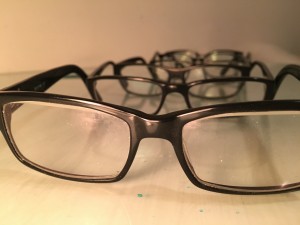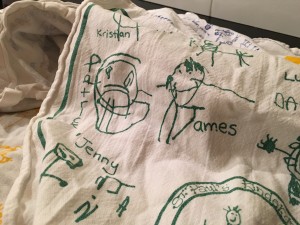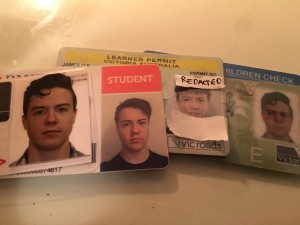Hyperactivity Might Not Be So Bad After all
After the first Lectorial, I proudly walked into work and told everyone that I was hyperactive when it came to learning. Although there is a somewhat negative stigma associated with being unable to focus on a single task for very long, or being able to thrive in an environment that is consistently shifting focus – I was quite proud of my new found ability.
My mum is a primary school teacher and every now and then we talk about how each new year level that comes through has had deeper and deeper engagement with digital technologies than the year level that came before them and how this might effect their ability to stay on task and be effective students.
Having a bit of an interest in this area, I wanted to see what others had to say on the topic and I was surprised that many people actually think that there lies a potential for cognition to be increased as a result of our every growing digitised world.
http://www.huffingtonpost.com/diana-graber/kids-tech-and-those-shrinking-attention-spans_b_4870655.html
Project Brief Two – Video Self Portrait
A minute long time constraint is actually a surprising blessing and curse when it comes to creating a self portrait. A blessing in that it permits you to refine a broad topic such as self reflection into something that can be conscience and which follows one idea.
This self portrait carries on from the first brief, in that I was attempting to explore the idea that self identity can be best verbalised or communicated through the way you carry yourself in public, using the small elements that make up how others see us to communicate our outlook on both ourselves and our environment.
I was initially intent on using all of the elements from my first project in this one exclusively however I couldn’t find a flow between these objects that effectively communicated self identity in one minute. Though I did use some footage and audio from the first project to compliment the new footage that I made.
In the editing process I wanted to utilise the idea of the gutter that McCloud talks about in Scott McCloud, 1993, ‘Blood in the Gutter’, Understanding Comics: The Invisible Art (Northampton, MA : Tundra Pub) by deliberately leaving sections of the video blank, either with or without audio behind it. The climax of the video comes with the quote that I remember from a couple of years ago that articulates how I view myself, I wanted to leave enough blank space to not only elevate the content that just preceded but to also give space for the audience to place themselves in the same context and to either agree or to roll their eyes in disagreement.
I would have liked to work out a better way to have connected the street performer, and the idea of me ‘preparing my identity’ within the confines of home. Retrospectively, deeper scripting and more editing sessions would have helped smooth out what I think is a jarring point in the video.
This is one of the first videos that I have created where I have narrated and the first time I’ve used this introspective tone in my voice, it was the part of the video that felt most natural to create and what I think ties the video together, I’m definitely interested in further developing this aspect of my content creation skills.
Project Brief One – Media Self Portrait
The identity of self, our perceptions of ourselves and our feelings towards ourselves, is an aspect of ourselves that isn’t created in a vacuum. The identity can be formed by goals, environments and the culture around us. For me, my identity is heavily focused at the moment of the binary between the home and the public. There are formal documents and clothes which beyond the home give a brief explanation of who I am, they are not necessarily entirely representative but they are physical components of what makes up my self identity.
How do you be creative?
Being creative seems like a skill that is as important as being able to type, read and talk not only in the media industry but in industries across Australia as we move to our human resources rather than our natural ones for our economic prosperity.
Gauntlett outlines this ability as being of fundamental importance in his blog post, What Kinds of Knowledge do we need to know. Which, for me at least, seems incredibly daunting. Being creative and feeling creative at times can feel like a subjective ability that some are better at than others. Definitely I have had days in the past week where I haven’t thought of myself being very creative at all.
It is incredibly important for ourselves to be able to unlock our creativity as well as the creativity of the teams that we work in, but this requires a shift from the thinking that creativity is a skill that exists in a select few. Because I’m a massive radio nerd, I have been watching a presentation given at Radiodays a couple of years ago that applies a different train of thought in relation to creativity, as it being a process rather than a talent.
The video goes for about forty minutes but contains some really interesting nuggets of information.
What I have been using from this presentation the most in recent days has been the mantra of ‘defining the problem’ which is actually really helpful and has helped me become not only more creative in my thinking but also in my ability to deal with certain projects, someone at work has told me that they are going to start explaining their problems to a teddy bear because it is the best way to work through a block in a thought process… my response was to make them an email account for the teddy bear. I am an effective worker.
Organisations and Governments fighting over us
Debate has been heated in the US recently over whether or not Government investigators should have the ability to seize information relating to individuals with the assistance of organisations, specifically technical organisations and more specifically, technical organisations that have a keen interest in fruit.
I’m honestly surprised that there was any debate surrounding this issue in the US, the rights of the individual have always seemed to me, from an outsider perspective, to be one of upmost importance. That said, there remains a somewhat grey social contract where at some point the rights of society trump the individual.
What I find most interesting in all of these debates, which crop up now and again, is that they relate to data that citizens have created and shared privately and yet almost seem to ignore these key stakeholders in the debate over who should have access to this data.
The Verge is one US based publication that I have been following on the FBI v Apple Case in relation to the San Bernardino attacks, who not only take on the approach of telling a story over quick ‘designed-for-the-commuter’ articles but also place a heavy importance in how content is presented.
http://www.theverge.com/2016/3/1/11142838/apple-bruce-sewell-iphone-encryption-china-privacy
So is Twitter dead?
 In response to Gauntlett’s proposition in his video about his new book Making Media Studies: The Creativity Turn in Media and Cultural Studies (2015) that media is, and particularly now, active and creative and moving away from the traditional view of there being a flow of Institutions > Texts > Audience we discussed in our workshop how that platforms used today by everyone with a phone to make media is in fact determined less and less by institutions.
In response to Gauntlett’s proposition in his video about his new book Making Media Studies: The Creativity Turn in Media and Cultural Studies (2015) that media is, and particularly now, active and creative and moving away from the traditional view of there being a flow of Institutions > Texts > Audience we discussed in our workshop how that platforms used today by everyone with a phone to make media is in fact determined less and less by institutions.
Where Facebook was initially a space for students at Harvard to connect, it has now become a pseudo morning newspaper that is used to gather news and watch videos. Where Snapchat initially came to be popular because of it’s ability to ‘safely’ distribute explicit material, it now a space where our most authentic selves in a digital context can be found. Where Twitter was yet another social network for individuals to share their ideas, it has become a breaking news platform and the place to go to question the quality of data services of Telcos and an interrogation room for finding out where your train is.
It was determined by our group that the modern day platforms of the post-broadcast era can’t be entirely planned out by institutions in terms of what their ultimate use is. Not only this but how these platforms are used by communities is dynamic, whilst the current uses of popular platforms was outlined above there is no more certainty than the time that these platforms were created that in six or twenty-four months they will carry the same use and purpose. Ultimately the community determines the platform’s validity, benefits and uses.
What is really interesting is communities often overlap, Venn diagrams of social connections exist over Instagram, Peach, Facebook, Instagram, Beme, Twitter and Ello, yet each of these are used in their own bespoke manner by the community. There isn’t a single platform that suits all.
While Twitter isn’t dead, it’s purpose and use is mobile. Though the institution develops new aspects of the platform and how it can be used, how it is used will determine it’s longevity and contributions to society.
Image used is by Luis Prado and can be found at https://thenounproject.com/term/dead-bird/3298/ Under Creative Commons Attribution 3.0
Why Media?
Gauntlett’s introductory video promoting his new book Making Media Studies: The Creativity Turn in Media and Cultural Studies (2015) provides an extremely optimistic point of view as to the value and the importance of the media as an institution in the post broadcast era.
Although I feel as though referring to media as ‘places’ can almost have the adverse effect of making media seem detached from everyday life, I do like how Gauntlett contends that media can be a place for conversation, exchange and transformation. Not only because these are very simple ideas but because they are three things that undoubtably are strengths of the institution.
In the past decade, and continuing on an unstoppable trajectory, the media landscape has become increasingly democratised with content creation being brought down to those who have access to a mobile phone and an internet connection. It should be noted however that there is still a significant way to go before there is a true globally interconnected society. The ability of governments to shut down mobile data networks and the reality of mobile phones and data plans remaining a luxury that isn’t priced at a point that places an emphasis on every single individual having access to a global conversation means that the institution still has space to develop and methods will have to be developed either formally or informally to ensure that when billions of individuals are all talking at once, that conversations take place based on merit rather than account balances.
Carrying on from media holding the sacred role of being a forum of the people, it being a place of exchange and sharing is an idea that I find equally as interesting. The ability for experiences to be shared carries over from the McCloud reading in week two, enabling humanity to build a greater awareness of it’s present state. Though Gauntlett raises an interesting point, the idea of ‘sharing’ has been co-opted by current dominate platforms as being one where less of an exchange occurs with a focus instead placed on the individual. That said, I do think that elements of Facebook, Twitter and even these blogs offer an exchange of ideas and experiences that have helped me develop my understanding of the world, and their value in this shouldn’t be undermined.
Finally, Gauntlett’s contention that the institution’s ability to make change in our communities is one that tilts media in the direction of being a place for good, with a moral obligation to society. There have been examples of media in a broad sense playing a critical role in social uprisings, such as the Arab Spring, as well as helping society develop a greater understanding of it’s citizens, as seen in the unmistakable role the media has played over time in society’s understanding of LGBTQ+ issues. Though it should be acknowledged that ‘slacktavism’ can sometimes result in pursuit of true transformation being replaced with becoming a meme, something that is popular now but doesn’t carry with it an engaged base who demand change in society.
In describing media as an institution which facilitates conversation, exchange and transformation, Gauntlett has kind of given me goosebumps as to how important the media can be in shaping humanity.
What is privacy’s value?
In our week three workshop, after discussing the adverse effects of ubiquitous media, I asked the question ‘What is privacy’s value?’
It has been a question that has been rolling around in my head ever since Snowden released the thousands of documents revealing the machinery behind government surveillance. I honestly don’t think many people that I know were shocked when we found out about the level of government surveillance that takes place, I spent a good while trying to work out why Snowden’s revelations were so groundbreaking because I’d always assumed that this level of knowledge of individuals had always been a factor of our connected era.
The thing is, the even with our Government passing legislation relating to data retention, I find myself not all that too concerned beyond the fact that the Attorney General may need some clueing up when it comes to talking like you understand how an internet works. I definitely come from the mindset of “if you don’t have anything to hide, then you don’t have to worry about anything”. I fully acknowledge two troublesome aspects to this train of thought; firstly it is effectively a white flag to any attempt to gain access to my information relating to any part of my life and places a great amount of trust in the organisations and institutions that transact my information with and secondly it is an extremely privileged opinion to have. I am fortunate enough not only to not have anything in my past that would detrimentally effect my future and as someone who is a middle-class, white, straight male I’m not necessarily at a high risk of having my information sought out. I’m not discrediting the value of privacy in this sense to society as a whole, the ability of each individual to choose how information relating to them is made available is pretty crucial to a functioning society, but for myself in particular I am still on a hunt for what makes privacy important for me.
My perception of the digital space is that it is hostile, particularly with my limited technical knowledge of the space. Though I am selective with the platforms that I engage with and the level of information that each of these have, ultimately the decision to share information with third parties is in effect a bet. A bet that the person on the other end of the fibre optic line firstly has your best interests at heart and secondly knows what they’re doing to keep these interests in tact.
Given the unstable nature of our connected society, I don’t think privacy can be considered a given for someone like myself. Certainly it is still a right, but an increased onus is placed on myself as a user of digital platforms to put in place failsafes to make sure that the information I share is something that I want known and that I have significant control over who can access the information shared.
In terms of value, if it can’t be assured and is something of personal responsibility, rights such as privacy become something of personal appraisal. Because I feel as though I am fairly private offline and selective with my online presence, online privacy is something of a nice afterthought for me, therefore limiting the true potential of the space as only a slither of what is presented is representative of my true self.
Is privacy valuable? Maybe, but it certainly cannot be assured.
The Norm
This blog post is about Scott McCloud, 1993, ‘Blood in the Gutter’, Understanding Comics: The Invisible Art (Northampton, MA : Tundra Pub)
The role of the audience and the narrative goal of a piece of media are two, now that I think about it, crucial elements of media creation. How content will be consumed and most importantly interacted with can be dismissed just as equally as narrative goal because of the ‘norms’ that have been created over time have become a given rather than something that can be manipulated. I acknowledge that my default for both of these elements of content production is what I’ll go on to describe as the norm but in now knowing that these norms exist, is the possibility to challenge them.
The first ‘norm’ that McCloud challenges is that of the role of the audience, which is not actually as ‘passive’ as it may appear from first glance or as is the norm. I have fallen into the trap of thinking that content such as a TV show is one where the interaction between creator and audience is skewed towards the generators when it comes to workload. After all, they wrote the script, organised crews, locations and cast and I am lying on the couch occasionally looking away from the TV and looking elsewhere. I am happy to admit that in this situation I feel as though I am not contributing to the process of consumption at all. I’m the physical representation of ‘passive’ in this situation.
McCloud’s reading challenges this line of thought though, initially describing the surprisingly complex action of ‘closure’ which presents our ability to perceive not only the physical world around us but the media we consume as something that is mentally stimulating. In this lies the idea that a story isn’t necessarily told by a series of shots and audio, even with the most skilful editing without an audience these are just pieces of disjointed content without meaning. It is actually the audience who apply meaning to content, not only making sense of what is presented to them but also applying their own experiences, interests and thoughts to the story being formed in their head.
This isn’t to suggest that there is a significant power shift in terms of media consumption, there is a need for media creators to ‘hold the hand’ of the audience to lead them through a story who’s path has been determined by generators but great opportunities exist to engage with the independent thinking audience as a secondary story teller. This can come from limiting the graphic and sonic information made available to the audience, creating a ‘gutter’ of information, or by presenting completely disjointing or unrelated content side-by-side and leaving the audience to either apply meaning to this or dismiss it instantly. There are many other ways that an audience can be engaged to ‘think’ that I honestly haven’t learnt about yet but the omission or lack of continuity between pieces of content seems like one of the simplest yet most effective ways to get the audience to think and build a story in their head.
Recently I was solving the problems of the world in a quiet, somewhat pompous, conversation with a good friend of mine on a late night train home. We came to the conclusion (I thought I came to it first, but apparently he had about two years ago… I concede that he did, but I still feel as though I deserve some credit) that we are limited by our ability to communicate our feelings, thoughts and ideas by tools that we invented to communicate in the first place; language and narrative. Language is somewhat mobile in my opinion, every year new words are being added to the dictionary and new meanings being applied to words. Literally. Narrative is a bit different however, it is considerably more robust and difficult to alter. I still remember the primary school library lesson where we were taught that every story has an introduction, conflict and resolution, that said there are countless outliers and many stories run multiple conflicts and resolutions throughout but the same basic formula is followed. It could be considered that this narrative recipe is a norm within media making.
McCloud challenges, or at least alerts us to, the fact that this isn’t a recipe that all of humanity follows and instead is a distinctly Western perspective to story telling, that is that it is goal orientated. It could be said that this is also just one example of how Western society as a whole is always seeking the next goal. The journey is fun, but the journey is being undertaken for the purpose of reaching a goal. He explains how Eastern art and specifically Manga places a particular importance on ‘setting the scene’ and being immersed in the story rather than being concerned about where the story is heading. This is slightly more complex than enrolling the audience as a co-story teller, but looking to move away from goal orientated story telling is something that I’d like to try out.
These norms exist for a reason and they aren’t actually bad, they are very effective at getting the job of story telling done but only following one line of thought can result in the strengths of what lies outside of the norm to be neglected. Actively trying to challenge these norms in everything that I make as a media maker isn’t feasible, but being aware of their existence I hope will allow me to acknowledge where something different would enhance the content that is created.
Authentically Communicating
My favourite quote from the second lectorial for the course came during the ‘What is Media?’ portion of the lesson.
Explained in Branston and Stafford 2010, The Media Student’s Book, 5th Ed, NY: Routledge, was a simple idea that the ‘media’ isn’t a heap of static things that are experienced in silos seperate from consumers lives but “places which most of us inhabit, which weave in and out of our lives”. It is also proposed that media seems “to flow around and through us, and they immerse most of our waking lives”.
The reality of our modern world is that, beyond a few seperate outliers, much of our human experience features and is moulded by multiple forms of mediated communications which set the agenda on every single issue; from nationalism to gardening, medicine to football, no aspect of human life is exempt from documentation and subsequent pieces which define the right and wrong, the desirable and the repulsive, what is funny and what isn’t.
Stepping stones such as the printing press, the radio, television, Facebook and Snapchat have seen the communication amongst ourselves develop from being unmediated and heavily reliant on the experiences of the individual to being one where media texts bring a collective knowledge to a now integrated community.
In experiencing the world and the people, events and ideas that inhabit it – there is a debate as to whether a face-to-face and direct interaction is more or less authentic than one of mediated communication.
The quintessential flag bearers of these conversations seem to our grandparents at Christmas dinner, I suspect because although they too have experienced the world in the era of mass communication there is an argument to be had that platforms such as newspapers, radio and television are more authentic than our 5″ screens because of the discussions that both of these still vital platforms facilitate within themselves, such as callers into radio shows, and within the face-to-face experience around the water coolers in offices and staff rooms.
The linking factor of these first and second generation mass media platforms is that they are all ‘broadcasters’ in nature, not just in technical specification. A single or a few selected lines of thought and discussion can be transmitted to the masses by creators and left to be debated between the colleagues and friends of the consumer. There exists a hybrid of these two experiences with these platforms, where elements of pre-modern society still exist ‘off the grid’ that is influenced by the distinctly modern elements of today’s society.
As we move deeper into modernity into a space which is now ‘post-broadcast’, the humble platform which you are using right now allows for a genuine flow of ideas to exist in one spot, providing it is used properly by it’s users (see: The Post or the Comment). It could be said, that in the sense of having a diverse, decentralised and beautifully inconsistent space for human interaction to exist that we are now blazing a trail in the first truely authentic media platform but this ignores a common action undertaken by all those who in someway engage in discussion online, the action of the edit.
Though all happening in the same space, at a rate far faster than direct communication, everything that has been posted by even the most amateur of poster has been reviewed to make sure a particular message, emotion or idea is communicated. It has been revised and emphasised before being published and although this simple act of checking provides for very articulate and representative vignettes of human thought, it is isn’t as authentic as face-to-face communication and direct experience.
That said, these elements of pre-modern communication aren’t infallible in being truely representative of human experience, their limiting factor of only being able to acknowledge what is known directly without having the capacity to tap into the greater known experience of humanity is the classic argument of Plato’s Cave and is inherently limiting in defining what is ‘real’.
Really, neither a communication that only takes place through texts or that only acknowledges direct interactions and experience are actually authentic. To have truely authentic communication, elements from both modern and pre-modern society have to be incorporated.






